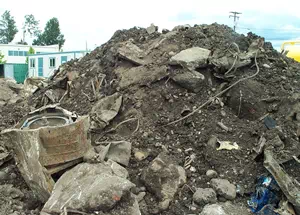Construction and Demolition Debris
Overview
Relevant Activities
Role of Local Governments
U.S. EPA Resources
Other Resources
States
Construction and demolition (C&D) debris refers to materials produced in the process of construction, renovation, or demolition of structures, where structures include buildings (residential, commercial, and institutional), roads, and bridges. Depending on the state's definition, C&D debris typically includes concrete, asphalt, wood, gypsum wallboard, paper, glass, rubble, and roofing materials. Land clearing debris, such as stumps, rocks, and dirt are also included in some state definitions. In most cases C&D debris is nonhazardous and thus regulated by states and local governments rather than by the EPA. An exception would be where C&D debris contains hazardous waste, such as removed asbestos insulation.
C&D debris is a significant issue in the U.S. because of the enormous volume of C&D debris generated. A large portion of C&D debris ends up in municipal solid waste landfills or in special C&D landfills, which may have the potential to contaminate groundwater. Also, each year, there is less land available for waste disposal. As a result, many state and local governments are seeking ways to divert C&D debris from land disposal, including by promoting recycling. Also, green building programs exist where the focus is on minimizing the generation of wastes.
- Solid Waste Disposal
- Bridges, Roads, and Other Infrastructure Construction & Maintenance
- Building Maintenance, Renovation, and Construction
- Transportation Planning, Operation, and Management
- Public Healthcare Services Operations
State and local regulations may limit locations for C&D debris disposal. For example, some local governments do not permit the disposal of C&D debris in their municipal landfill. Also, some local governments, particularly in California, require construction companies to recycle a minimum percentage of the C&D debris generated.
U.S. Environmental Protection Agency Resources
Sustainable Management of Construction and Demolition Materials. EPA website providing information and resources for managing and reducing C&D debris.
All Hazards Waste Management Planning Tool. This interactive online tool helps emergency managers develop pre-incident waste management plans for both natural and man-made disasters.
Managing Your Environmental Responsibilities (MYER): A Planning Guide for Construction and Development. This document explains in detail the environmental obligations that construction companies can face across the various federal laws (stormwater, air, wetlands, waste). Use it to factor in costs during the bidding process, assign responsibilities and use the checklists to self-audit.
Building Savings: Strategies for Waste Reduction of Construction and Demolition Debris from Buildings. Fact sheet aimed at local governments that want to encourage more building-related construction and demolition debris recovery, building owners and developers interested in green building design, and building contractors seeking a competitive edge.
Construction & Demolition Debris State Locator. Use this tool to locate regulatory information and other compliance assistance and pollution prevention resources for your state. It is also recommended that you contact your city or county government to determine if local rules also apply to your project.


